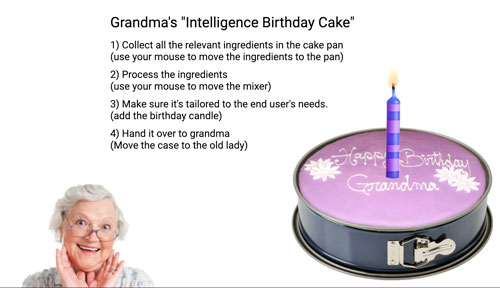Peter Huppertz
Peter Huppertz
Blog entry by Peter Huppertz
In the world of eLearning, where the goal is to convey complex concepts and foster deep understanding, the use of humour can be a game-changer. It breaks down barriers, makes content more relatable, and, most importantly, helps learners connect emotionally with the material. Based on my own experience and supported by research, humour can be a powerful tool in creating impactful eLearning experiences.
A Personal Experience: Grandma’s Intelligence Birthday Cake

In one of my eLearning projects, we needed to explain the components of good intelligence that could be used in law enforcement case work. Instead of opting for a straightforward, textbook explanation, I decided to add a bit of humour into the module. The result was an interactive task called “Grandma’s Intelligence Birthday Cake.”
Participants were asked to virtually add ingredients to the cake, mirroring the process of selecting good intelligence and leaving out the bad. The mixer represented processing intelligence in case work, while decorating the cake symbolised tailoring the intelligence report to the recipient’s needs. Finally, handing the cake over to Grandma equated to disseminating the intelligence. Each step in creating the cake humorously referred to the steps in the Intelligence Cycle.
The reactions were overwhelmingly positive. While a small minority felt the exercise might not be entirely suitable, the majority of users loved it. What stood out was how memorable the session became. Learners would refer back to it, saying, “Do you remember the session with Grandma’s cake?” or “This was the course with baking intelligence.” This demonstrated that humour not only engaged them but also helped them retain the information long after the course was completed.
The Role of Emotions in Learning
This experience aligns with research on the role of emotions in learning. Positive emotions, such as those elicited through humour, help students engage with learning for longer periods. When learners are motivated and emotionally invested, they are more likely to remember what they’ve learned and develop a positive attitude toward the material. According to Dr. Study Learning, “Positive emotions can help students engage with learning longer because they stay motivated. Emotions during learning also impact our feelings toward education. If we have positive experiences, we are more likely to enjoy our schooling and develop a love of learning.”
Similarly, research published in the Technology Enhanced Learning Research journal highlights that incorporating emotions into learning environments can significantly improve learner engagement and outcomes. Humour, when used effectively, can create these positive emotional experiences, making the learning process not only more enjoyable but also more effective.
Why Humour Works in eLearning
Humour in eLearning works for several reasons:
-
Increases Engagement: Humour captures attention and keeps learners engaged, making them more likely to stay focused on the material.
-
Enhances Retention: By making the content memorable, humour helps learners retain information better. Just as the participants in the “Grandma’s Intelligence Birthday Cake” exercise remembered the process, humour can create lasting mental associations.
-
Reduces Stress: Learning complex or challenging material can be stressful. Humour can lighten the mood, reducing anxiety and making the learning environment more comfortable.
-
Promotes a Positive Learning Experience: When learners enjoy the content, they are more likely to view the entire learning experience positively. This can lead to greater motivation and a deeper love of learning.
-
Facilitates Understanding: Humour can simplify complex ideas by presenting them in a relatable, often metaphorical way. It allows learners to grasp concepts more easily by linking them to familiar or amusing scenarios.
Guidelines for Using Humour in eLearning
While humour can be a powerful tool, it’s important to use it thoughtfully and appropriately. Here are a few guidelines:
-
Know Your Audience: Understand the cultural and social context of your learners. What’s funny in one context might not be in another.
-
Keep it Relevant: Ensure that the humour is directly related to the learning content. Irrelevant jokes can be distracting and reduce the effectiveness of the lesson.
-
Balance is Key: Don’t overdo it. While humour can enhance learning, too much can undermine the seriousness of the content or make it seem less credible.
-
Test and Iterate: If possible, test the humour with a small group before rolling it out to the entire audience. Use their feedback to refine your approach.
Conclusion
Incorporating humour into eLearning can transform a standard course into a memorable and effective learning experience. By engaging learners emotionally, humour helps them stay motivated, reduces stress, and enhances retention. As my experience with “Grandma’s Intelligence Birthday Cake” demonstrates, humour not only makes learning more enjoyable but also fosters better outcomes. When used appropriately, humour can be an invaluable tool in the instructional designer’s toolkit, leading to courses that learners remember and appreciate long after they’ve finished.
By understanding the power of humour and applying it thoughtfully, we can create eLearning experiences that are not just informative, but also truly impactful.
